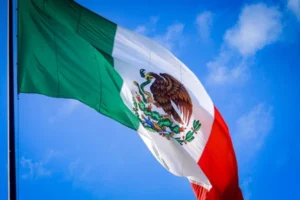And they called it Teotihuacan…
The city of Teotihuacán was once one of the most cosmopolitan places in pre-Columbian America. Abandoned it was already in the times when the Aztecs arrived in the city, amazed by the majesty of its buildings, they baptized it as Teotihuacán which in the Nahualt language means “place where the gods were born or city of the gods”. Sitting 15 kilometers off the coast of Lake Texcoco in the Teotihuacan Valley on the San Juan River, it is located about 50 kilometers from Mexico City. It is one of the most important archaeological sites in Hispanic America because it housed a structurally developed society in the commercial, economic, political, religious and cultural.
Teotihuacán, icon of Mexicanness.
In its period of greatest splendor, 200 AD.c., the city of Teotihuacán came to have more than 120,000 thousand inhabitants evidencing a highly hierarchical society, with some development in science and the arts. Their ethnic features came to cross the limits radiating to the rest of the Mexican highlands, perpetuous to this day. Its importance is such that in 1987 it was named Cultural Heritage of Humanity by UNESCO and is visited every year by thousands of people becoming one of the main tourist destinations in Mexico. Teotihuacán is an icon of Mexicanness. Its architecture, specifically the Pyramid of the Sun, is a symbol of Mexican culture and Indian-incracy. It has become a flag for the research, defense and preservation of the Mexican national archaeological heritage.
Expansion of the Teotihuacan culture.
Teotihuacán was constituted in a commercial emporium with the exploitation and sale of obsidian or volcanic stone, throughout the region of Mesoamerica as well as the export of its ceramic tripod vessels. The discovery of the deposits near Teotihuacán made it a creditor of its monopoly and was used as an object of domination and subjugation by the inhabitants of the city. With this favorable panorama in the commercial, Teotihuacán extended its area of influence beyond its boundaries even in the military strategic and with clear archaeological indications of political influence in sites such as Monte Albán, the Mayan region and in Tikal.
The architecture of Teotihuacán
The space open to the public of the city covers an area of 264 hectares where its buildings are located. Its architecture stands out for its monumentality in addition to being sober and elegant mainly its pyramids. Among them stands out for being the most important the Pyramid of the Sun with 63 meters high and its square base of 220 meters per side, the number two in size in Mesoamerica after the pyramid of Choluca. Built with adobes, clad in stucco and ornamented with religious mural painting, it consists of five platforms and six segments of stairs which lead to the top where a ceremonial altar was located.
Smaller follows the Pyramid of the Moon with 40 meters high with a rectangular base of 120 x 150 meters. The Causeway of the Dead is a central axis, north-south direction that begins with the Pyramid of the Moon and passes through the Pyramid of the Sun. At the southern end is the Temple of the Feathered Serpent or Temple of Quetzalcoalt, the main deity next to Tlaloc, god of rain. It is a construction of six ornate bodies with 365 heads of both gods protruding from its walls. Around it there are thirteen minor step pyramids and housing complexes for priests called The Citadel.
The Palace of Quetzalpapálotl is a complex of ruins that is accessed by the avenue of the dead located southwest of the Pyramid of the Moon. It is presumed to have been home to high priests or senior officials. There were also ceremonial acts in an enclosure beautifully decorated by polychrome murals and its stone columns sculpted with figures of butterflies and quetzal feathers, hence its name. The entire main complex of the city is accessed by five gates that lead to stone paths that cross the buildings.
Being an agrarian civilization, it was built with a good system of provision and drainage of water. Teotihuacán is a city of wide roads, planned in advance with grids and urban layout with two perpendicular axes, the east-west road (road of the dead) and the north-south road.
The first was thought to be due to the existence of tombs. The one that gains greater strength within the researchers is that it was a procession road that led to one of the most sacred sites in the city as it was the Pyramid of the Moon. The pyramid and its square was publicly accessible as it was a ceremonial cultural site unlike the Pyramid of the Sun to which only priests accessed.
All the small temples that are around it face the interior for the control of the entrance and exit of the acolytes who attended. It is presumed that near the temples were housing constructions ornamented with living murals where the priests resided.
The Teotihuacan art represented in his mural painting was an expression totally subordinated to the ornamentation of architecture. This city is one of the best preserving the vestiges of fresco painting in Mesoamerica. Its greatest flowering corresponds to the polychrome murals of Teplantitla, Tetitla, Atetelco, La Ventilla and the Wall of the Jaguars in Quetzalpapálotl as well as the stucco cladding attached to the buildings.
The city was a transit site where many foreigners arrived because it was a commercial metropolis and of great influence for the rest of Mesoamerica at the time. Since the nineteenth century the excavations began becoming a great center of archaeological research, one of the most important in Latin America and that has not yet been explored in its entirety.
Cosmogony
The planning and construction of the city corresponded to the worldview of its inhabitants and its integration with the environment following astronomical criteria that indicated the harvest season. The positioning of the Pyramid of the Sun and the Citadel marked the protrusion and the west of the star king at the propitious moments for the initiation of the same as well as the rituals that favored it.
Until a few years ago it was believed that this city was built in honor of the sun god represented in his pyramid, but discoveries have incorporated other deities who possibly were also offered its construction by expanding this cosmogonic system. Hence the veneration of Tlaloc, god of water and rain, with his head attached to the Pyramid of the Feathered Serpent and figures found in underground caves; Huehuetéoltl, god of fire, statue found at the top of the Pyramid of the Sun; Chalchiuhtlicue, goddess of the waters, regent of the Pyramid of the Moon and at whose top offerings were made in her honor; and figures of the jaguar, symbol of fire, the sun and the underworld.
Near the Pyramid of the Moon was found a structure called Quincunce or Teotihuacan Cross whose symbology in Mesoamerica represents the cosmological order. It symbolizes the representation of the division of the universe by four regions governed by the cardinal points and in turn three vertical sections representing the sky, the earth and the underworld.
Within this belief system enters Quetzalcoatl or the feathered serpent, a deity who is attributed as the initiator and ruler of man’s activities on earth, giver of everything that man produces and modeler of time represented in his headdress. He is credited with creating the calendar. The temple that was built in his honor departs from the whole towards the southern path of the Causeway of the Dead but is the most majestic and perhaps the most beautiful decorated in all of Mesoamerica.
Ornamented with shells and sea snails, it is presented with feathered snake heads carved in stone, crowned with two petals that project from a flower. There are many conjectures and hypotheses about the abandonment suffered by Teotihuacán by its inhabitants: civil war, internal disputes, droughts or attacks from neighboring communities tired of their domination. One of the theories suggests that it was destroyed for the seventh century by a voracious fire being abandoned by the few inhabitants who remained after glimpsing its fall as a commercial, economic and religious emporium to emigrate to neighboring cities.
Museums and more
To complete your knowledge of this valuable civilization it would be important that you complement your tour to the varied cultural and exhibition sites that Teotihuacán has as an archaeological center. The Site Museum of the Teotihuacan Culture with the exhibitions of ceramics, utilitarian objects of obsidian, shell and bone of the time as well as the Botanical Garden with the exhibition of the flora of the area. Both are located south of the Pyramid of the Sun.
It is also worth approaching Tepantila where we will find the Tlatocan, a majestic mural that narrates the paradise of Tlaloc and that will only take you 15 minutes on foot leaving through door 4 of the complex. If you want to deepen the various investigations on Teotihuacán you should approach the Center for Teotihuacan Studies. Excellent place for the reference and historical, archaeological and anthropological documentation of the city, it has a video library, planoteca and photo library accessible to the public 15 minutes walk in front of door 5.
If you are a lover of art and mural painting, a must visit to the Museo de Murales Teotihuacanos Beatriz de la Fuente where a photographic record of the murals of the city is exhibited. The archaeological zone of Teotihuacán is administered by the National Institute of Anthropology and History of Mexico. Its visiting hours are from 8:00 a.m. to 5:00 p.m. Its access is free for seniors, children, students and teachers upon presentation of credential.
On weekends it is free for all Mexicans but not for the foreign tourist who must cancel entry all year round. Nearby areas and underlying communities have hotel chains and camping sites. You can also count on a gastronomic offer native to the area. So to connect with the ancestral history of Mexico you must make a mandatory stop through this magical and mysterious city.











One Response
I found this post very helpful which I found on yahoo.Thank you for sharing this information.